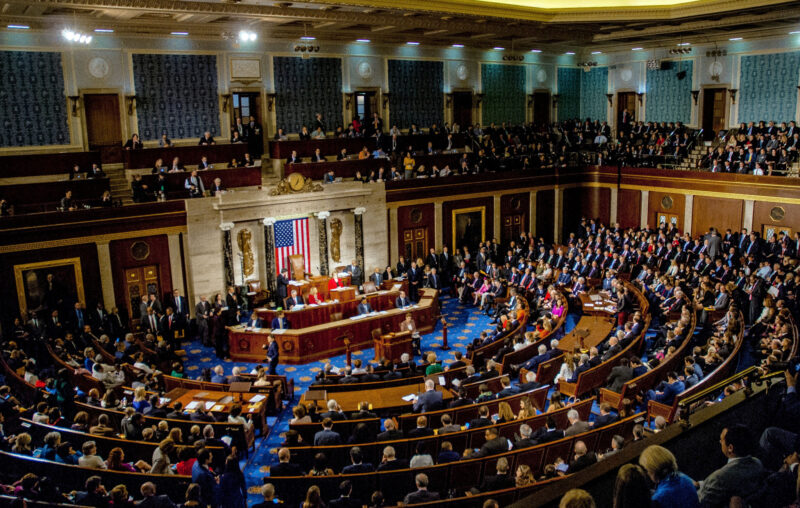Rules over Discretion Provide a Path Forward

Congress hasn’t done its primary job of passing a balanced budget or even a full-year budget in decades. This must change soon before the fiscal crisis gets worse. But that’s unlikely because few seem to care.
Congress recently passed the third continuing resolution for fiscal year 2024 in the amount of $1.7 trillion. This budget legerdemain kicks the federal budget to March, when members will repeat the same omnibus process, one fraught with hijinks and grandstanding. Instead of an actual debate about what we should or should not spend on a department and agency basis, we get calls to “shut down the government” if any number of demands aren’t met. Now, there’s a “bipartisan tax deal” that could add more than $600 billion to the debt over a decade.
Democrats don’t seem to care about the debt much, and some who adhere to the ideology of modern monetary theory even think it is helpful for economic growth. But the Republicans also seem to have little, if any, courage to restrain spending, so they just keep cutting taxes and spending us into greater levels of debt.
The late, great economist Milton Friedman said, “I am in favor of reducing taxes under any circumstances, for any excuse, with any reason whatsoever because that’s the only way you’re ever going to get effective control over government spending.” But spending is the ultimate burden of government on taxpayers and must be addressed first.
The Republican agenda has prioritized border security, rightly or wrongly, over everything else to deal with a humanitarian crisis along the border with Mexico. Former president and top GOP presidential contender Donald Trump has insisted on prioritizing this issue. Events at the border continue to boil with the fight between Texas Governor Greg Abbott and President Biden after a recent Supreme Court decision. The decision has limited reach as it “temporarily allows the Border Patrol agents to continue cutting and moving the razor wire installed by Texas. However, since the ruling came through the emergency docket, the case is now passed back down to the lower court, who will hear the case with oral arguments.”
The Republican pursuit of an aggressive border security deal as the number one priority risks further inflating bloated spending as the issue gets subordinated.
While some argue that illegal immigration costs far more than border security, compelling studies indicate that immigrants, when provided opportunities, make substantial contributions to society, enriching the economy. The more aggressive approach to border security during Trump’s term contributed to extravagant federal deficit spending. There has also been a high cost to Texans in the state’s budget to address border security issues of more than $5 billion in the current budget and at least $5 billion more since 2016.
Addressing illegal immigration issues and averting an impending fiscal crisis requires substantial debate about these issues rather than the current partisan-fueled fire drill over continuing resolution funding. With budget deficits expected to be at least $2 trillion per year over the next decade and net interest payments recently surpassing $1 trillion, every scarce taxpayer dollar must be used wisely, if at all. This could be done with market-based reforms that would foster better fiscal, economic, and border situations.
Economist Richard Vedder and others proposed an immigration approach that would create an international market for visas whereby the government issues some of them for refugees, and the rest are auctioned off to people willing and able to purchase them. The government could use this money to pay down deficits, and there would be better accountability for those with visas while providing necessary resources along the border.
The biggest national threat continues to be Congress’ profligate spending, which the primary drivers are so-called “entitlements” and must be swiftly reformed with market-based approaches. But right behind it is the Federal Reserve’s bloated balance sheet, which must be addressed.
Despite a 14 percent reduction since its peak of about $9 trillion in May 2022, the Fed’s balance sheet remains a staggering 85 percent higher than pre-pandemic levels. Lingering issues of the Fed running losses of $116.4 billion last year, propping up struggling financial institutions with its costly bank term funding program, and the ongoing cost of trying to artificially hold down market interest rates as federal budget deficits soar exacerbate a fiscal-monetary crisis.
Manifestations of the underlying economic malaise are evident in falling real wages down 1.3 percent since Biden took office, inflation surpassing set targets, unattainable housing affordability, and families grappling with saving money. These symptoms, rather than isolated issues, indicate the pervasive consequences of unchecked government spending and money printing, casting a long shadow on Americans’ well-being.
The latest efforts by Congress to pass the continuing resolution and propose the latest tax deal will make the fiscal situation worse. While the latest idea of a fiscal commission could do what is good in theory, there are already calls to raise taxes, which will be detrimental to the economy and the fiscal picture.
The path forward must be fiscal sustainability. This includes a long-term solution of a spending limit. The limit should cover the entire budget and hold any growth to a maximum rate of population growth plus inflation. This growth limit represents the average taxpayer’s ability to pay for spending. Doing so would have resulted in just a $700 billion increase in the debt instead of the actual increase of $20 trillion from 2004 to 2023.
The spending limit should be combined with a monetary rule that removes much of the discretion of central bankers. This will support sound money. It can be achieved by moving to a single price stability mandate and preferably a high-powered money growth rate rule of the Fed’s assets. Other rules include the Taylor rule or nominal GDP targeting.
While each of these rules has pros and cons, the money growth rate rule advocated for by Milton Friedman is the simplest. It’s simply a rule based on how fast currency plus bank reserves grow. This would be the easiest for the public to understand, to hold officials accountable, and to tie the Fed’s balance sheet directly to inflation.
John Taylor proposed what’s been coined the Taylor rule that estimates what the federal funds rate, which is the lending rate between banks, should be based on the natural rate of interest, economic output from its potential, and inflation from target inflation.
Scott Sumner most recently popularized nominal GDP targeting, which uses the equation of exchange (MV=Py) to allow the money supply times the velocity of money to equal nominal GDP. There are different variations of it, but the key is that velocity changes over time, so the money supply should change based on money demand to achieve a nominal GDP level or growth rate over time.
Rules over discretion, at least until we can rightfully end the Fed, should hold those in Congress and at the Fed in check because their limited knowledge will always result in bad outcomes for people in the marketplace. Such measures are pivotal in preventing further debt accumulation, safeguarding America’s credibility, and preserving the economy’s stability.
The choices made today will reverberate into the future, shaping the economic landscape for future generations. This call to action is for policymakers to tread carefully, adopt prudent fiscal and monetary sustainability through a rules-based approach, and prioritize the long-term well-being of the country with market-based reforms over short-term politics.
Failure on these issues will prevent us from addressing the humanitarian crisis along the border, China, or other concerns. These efforts will be challenging, but they’re essential for freedom and prosperity.










